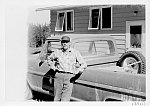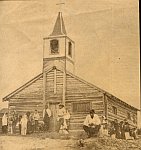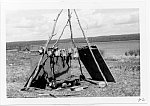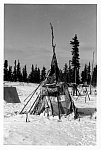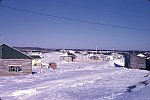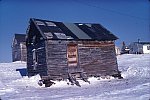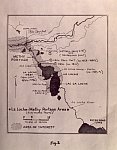History of the Denesuliné (Dene) in Northern Saskatchewan
Author: Anne Mease Page 1 | Page 2 | Page 3
Denesuliné in Treaty Eight:
Black Lake, Fond du Lac, and Clearwater River (La Loche)
History:
The Denesuliné in and near Black Lake, Saskatchewan were formerly known as the Stony Rapids Denesuliné. They now refer to themselves as the Black Lake Denesuliné Nation. 'Tazen tuwé' is the self-naming term for Black Lake and literally means Black Lake. The self-naming term for Stony Rapids is 'Deschaghe' which means 'settlement on the other side of the Rapids.' [9]
Location:
The community of Black Lake is located approximately 170 kilometres southeast of Uranium City. Aside from Fond du Lac, it is Saskatchewan's most northern community. There is no year round access road into Black Lake due to its remote location. The nearest airport to Black Lake is 16 miles away in Stony Rapids.
The total land base allotted to the Black Lake Denesuliné Nation through an adhesion to the Treaty 8 agreement in 1899 is 32,819 hectares. There are three bands of Black Lake Denesuliné who share the allocated reserve land. They are Chicken No. 224, Chicken No. 225, and Chicken No. 226. David Thompson of the Hudson's Bay Company first surveyed the area from Reindeer Lake, Wollaston Lake, and Black Lake in 1796.
Population:
The population in Black Lake has risen steadily over the past 70 years. In 1932, Father Eugene Picard of the Roman Catholic Mission in Black Lake reported there were "230 people or 65 families from the Black Lake region." [10]
By 1970, there were "535" Denesuliné living in Black Lake. This is an increase of "250%" over a span of "forty-three years" [11]
In 1997, there were approximately "four thousand" Denesuliné living in Stoney Rapids, Fond du Lac and Black Lake.
As of 2005, there are approximately 1699 Denesuliné living in the community of Black Lake, SK.
Language:
Though there was a significant language loss that began in the 1970s, the use of Denesuliné is now very prominent in everyday use in Black Lake. In fact, Denesuliné is the first language taught to infants and children. [12]
In 1996, of the "1,055" Denesuliné registered in Black Lake, "1005" reported 'other' language as their mother tongue or first language.[13] The 'other' language refers to Denesuliné or Chipewyan. English is considered a second language in Black Lake.
Education:
The Black Lake school that was built in the early century has been replaced a newly modernized and up to date facility. The newly named "Father Porte Memorial Denesuline School has approximately 400 students enrolled. Eight of [the] 21 educators are band members and�[they have] 16 teacher assistants who participate in daily classroom activities."[14]
Religion:
Since the arrival of the newcomers, many Denesuliné have adopted the Roman Catholic faith. The Roman Catholic Church built their first church in Black Lake in 1951.
Today many Denesuliné are relearning and practicing traditional forms of spirituality. The sweat lodge is one of the spiritual ceremonies being re-introduced back into Denesuliné spirituality.
Organization:
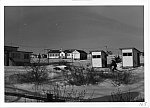
Black Lake Band Council Hall centre; Old Nursing Station left; Indian Affairs storage shed right, 1971
An elected Chief and 5 Council govern the Black Lake Denesuliné Nation. They are affiliated to the Prince Albert Grand Council and the Federation of Saskatchewan Indian Nations.
Economy:
Traditionally, Black Lake Denesuliné were nomadic hunters who followed the large herds of Beverly caribou in search of food. Hence their name 'Caribou Eaters.'
Fishing was an important aspect of subsistence for the Denesuliné and their dogs. Whitefish was generally saved for human consumption while other fish such as suckers and walleye were saved for the dogs.
Late summer was the best time for fishing as it was close to freeze-up. The collected meat and fish could be frozen during this time. Otherwise, the fish and meat was preserved through sun drying or smoking in the spring and summer months. The process of drying fish was necessary because freezers were unavailable in Black Lake region.
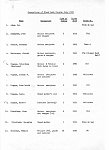
A census of occupations in Black Lake by U of S Professor R.M. Bone in 1971 indicated that trapping was still a way of life for the majority of Black Lake Denesuliné.
In fact, in the early 1970s, there was only one freezer that was shared by everyone in the community. The Band Council and Priest were responsible for holding the key and allowing people access to the freezer. This became troublesome as they had no set hours and people would ask to access the freezer at any given hour.
Into the 1970s, hunting and trapping continued to be a major source of income and subsistence for many Denesuliné from Black Lake. Other jobs that were available to those in Black Lake were mainly seasonal jobs such as hunting or fishing guides, diamond drillers, or fire fighters.
Today, many Denesuliné participate in the work force full time in Education, management, clerical, mining, Band administration, Social Welfare, Health, construction, and Government.
The community of Black Lake received $2,2289,834.00 in Government transfer payments in 2004.[15]
The average income in Black Lake is $29,247.00 per annum.
Fond du Lac
History:
Fond du Lac is one of the oldest, most northern remote communities in Saskatchewan. The North West Company first established Fond du Lac as trading post in the late 1790s to early 1800s. However, they abandoned the site in '1804' after numerous attacks and massacres which were apparently initiated the by ' Chipewyan.' The Hudson's Bay Company re-built the post in '1819.'
When the HBC and the NWC merged in 1821, they abandoned the site to a more feasible location in Fort Chipewyan. " Jose Mercredi," who was in charge of the previous NWC post claimed to be the founder of present day Fond du Lac when he established the settlement in '1845.'
In '1851,' the Hudson's Bay Company built their post in present day Fond du Lac and it "has remained in operation at Fond du Lac from (at least) 1851 to contemporary times, when its stores have transformed into the "Northern" company."[16]
Location:
This small isolated community of Fond du Lac is situated approximately fifty miles from Uranium City. It is a fly in only community.
Population:
Fond du Lac is predominately a Denesuliné and Metis community. There were approximately 642 Denesuliné in Fond du Lac in 2005. This number is down from 751 in 1996. There was an even distribution of approximately 340 men and 340 women in Fond du Lac in 2005.
Language:
The use of Denesuliné as a first language is rapidly deteriorating in the community of Fond du Lac. Denesuliné speakers in Fond du Lac speak the k dialect.
Education:
Denesuliné in Fond du lac have a high incidence of school dropout rates. In the age category of 45-65 there are 75% who have not completed high school or secondary education.
Religion:
The Denesuliné in Fond du Lac are predominantly Catholic with a few practicing the Protestant faith while the others subscribe to traditional spirituality.
Organization:
The Fond du Lac Denesuliné First Nation are politically guided by Section 11 of the Indian Act (1876). They have a customary Chief and Council election system in place. They are affiliated to the Prince Albert Grand Council in Prince Albert, Saskatchewan.
Economy:
In 1931, Fond du Lac boasted "3 stores�and gasoline." [17] Today, Fond du Lac has a new gas bar, convenience store, and fast food outlet
Fond du Lac's main source of economy is through mining and mineral extraction.
The community of Fond du Lac received $6,594,191.00 in Federal transfer payments in 2004.
The average income in Fond du Lac is $33,645.00 per annum
Clearwater River (La Loche)
History:
The Clearwater River Dene Nation consists of three bands including reserves 221 and 223. The Clearwater River Dene Nation used to be known as the 'Big C.'
In 1778, Peter Pond established the first trading post in the area of Clearwater.
Location:
The Clearwater River Dene Nation is located near La Loche, Saskatchewan. Clearwater is approximately 350 kms from the nearest service center in Meadow Lake. The reserve land that was allotted during the signing of Treaty Eight covers approximately 9,500 hectares.
Population:
1471 were registered with the Clearwater River Dene Nation in 2005. Just over half (813) of the Band population lives off reserve.
There are only 10 persons registered in reserve 223 of the Clearwater River Dene Nation.
Language:
Denesuliné is the main language spoken in Clearwater with English as a second language
Education:
Just over 50% of the population in Clearwater does not have any type of secondary or post-secondary training.
Religion:
Occupants of Clearwater practice traditional forms of spirituality along with the Roman Catholic faith. More recently, sweat lodges are being introduced as traditional forms of spirituality.
Organization:
Clearwater Denesuliné First Nation are governed by a Chief and Council that is mandated by Section 10 of the Indian Act (1876). They are affiliated with the Meadow Lake Tribal Council Program Services INC (MLTC Program Services INC) in Meadow Lake, Saskatchewan.
Economy:
The unemployment rate at La Loche is very high. The mine manager reported "about 250 people had worked at the mines during the past 15 years."
The average income in Clearwater is $27,315.00 per annum. ['Source']
Endnotes
[9] Article: Post Reserve: Present Day Reserves in Saskatchewan. Saskatchewan Indian Cultural Center Heritage Website. Saskatoon, Saskatchewan. <http://www.sicc.sk.ca/heritage/ethnography/dene/territory/postreserve.html>
[10] The Geographical Movements of the Chipewyan Indians of the Black Lake Region from the Winter of 1931 to the Summer of 1932. University of Saskatchewan Archives: R.M. Bone fonds (240)
[11] Henry Sharp. The Kinship Systems of the Black Lake Chipewyan. Dissertation. Drake University, 1973:25.
[12] Excerpt from: "Aboriginal languages of Canada" by Eung-Do Cook and Darin Howe, Chap. 9 in W.
[13] 2001 Community Profile - Chicken 224. Statistics Canada <http://www.statcan.ca>
[14] ECN: Black Lake First Nation Education. <http://www.indianclaims.ca/english/pub/proceedings.html>
[15] Wilfred Lentz, Chartered Accountant. Black Lake. Schedule of Government Funding, March 2004. <Black Lake20032004.pdf>
[16] David Meyer. "The Fur Trade Period" in Human History in Far Northern Saskatchewan.<http://canoesaskatchewan.rkc.ca/arch/archhist.htm>
[17] R.M. Bone fonds (240). Recollections of Father Eugene Picard of the Stony Rapids Chipewyans, 1931-1934. University of Saskatchewan Archives, 28 July 1971:15



